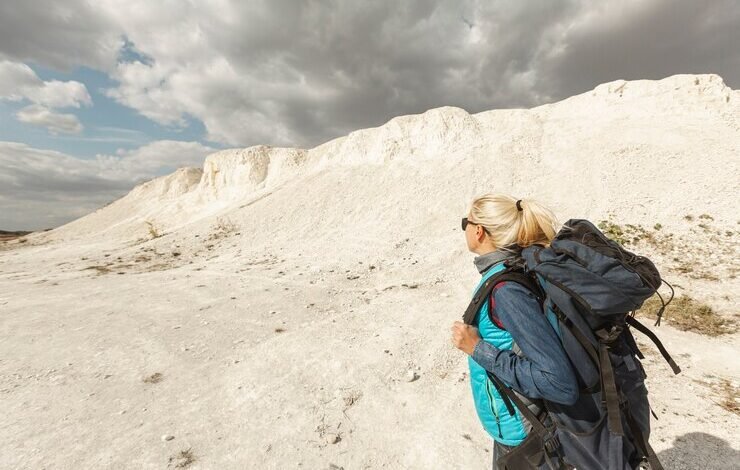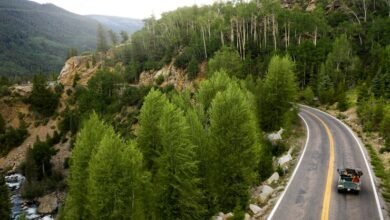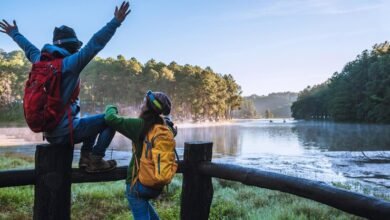Journey to the Roof of the World Everest Base Camp Trek

Widely known as a trek to the “Roof of the World,” journeying to Everest Base Camp is an adventure in many peoples imagination and soul. Tucked away within the mighty Himalayas, this trail provides more than merely splendid landscapes — it is a holistic cultural immersion. Starting in the idyllic town of Lukla — reached by a thrilling scenic flight from Kathmandu — the trek plunges adventure seekers into an elaborate Sherpa culture laden with traditional villages, welcoming smiles and monasteries adorned with intricate Buddhist architecture.
You find sprawling green valleys, the banks of rushing rivers and the sight from above as great peaks tower over dominantly: Mount Everest with its radiant glory. Every step of the way shines with the each descending bloom lining the trail to mineral streams flowing like glaciers that reflect light back into your face. The atmosphere feels colder, and thus much closer to heavens. It is more than just a physical awakening; it is an encounter with the rawest of nature that will make you bow down in reverence.
On the way trekkers hike through quaint villages like Namche Bazaar, the colorful hub of Khumbu region. The local markets here are vibrant, overflowing with ethnic handicrafts, local delicacies, and cheerful conversations of Sherpas. While acclimatization days in Namche present with stunning panoramas of the Everest massif, as well as distant mountain views that can leave one breathless. The dark rock faces against the bright white snow leave a lasting image in ones memory.
The lush ascent to Everest Base Camp gives way to increasing barrenness. While the lushness of the forest fades into a rocky and glacial landscape, air thins notably – each breath to remind hikers what altitude they are tackling them. It is different every day, but that makes it fun and we are all in the same boat so there was camaraderie of shared experiences among the other trekkers and with local guides. Stories are shared, laughter fills the trails, and each little victory — getting to a difficult pass or seeing the sunrise on top of the mountains — Is celebrated.
Everest Base Camp comes as a victory. As far as words can describe, standing at the foot of tallest mountain in the world with mighty Khumbu Icefall and high peaks surrounding it – is beyond word experience. It is a dream factory, an ambition conduit for climbers planning their audacious bids on Everest. It is something that fills the soul with a sense of accomplishment and the physcial beauty of the landscape scarred will also mange to leave its mark surrounding you in everything around. The journey to Everest Base Kamp is more than just a physical endeavor, but a step into the heart of natural beauty and strength and the unending call of exploration on nature itself; lasting companions for memories.
What to Experience in The Everest Base Camp Trek — Introduction
Everest Base Camp Trek is one of the most famous trekking routes in the world that lures many trekkers and nature lovers to experience the aura and beauty of the Himalayas. This trek in Nepal has been cut down to size and is a unique hiking trail, giving you all types of landscapes through rich culture & making you experience achievement. The trek starts in the tiny town of Lukla, which sees trekkers set off on an amazing journey through green valleys and past picturesque villages as well as jaw-dropping mountain views. In between, there are incredible sightings of some of the highest peaks in the world — including Everest itself.
It takes about 12 to 14 days to complete the trek, which is somewhere around 130 kilometers round-trip and with over a 2000 meters vertical gain. Trekking follows the rocky trails over suspension bridges, combined with the warm hospitality of local Sherpa communities. It is a unique trek, more than being a physical endurance test, it takes you through diverse ecosystems and cultural antiquity on which was once known as the untrodden path of Nepal with insights to the Sherpa people who lived in solitude amidst nothing but nature and mountains. No matter whether you are an experienced trekker or new to the world of adventure, Everest Base Camp Trek is going to be a great experience in your life where you get plenty of memorable experiences made inside along with mesmerizing view of beauty expressed by the nature itself standing at the foot of world’s highest peak.
Trek Planning: Permits and Pre-Trek Prep
Careful planning In order to consider Everest Base Camp Trek Cost you need to plan very carefully about different aspects like permits and preparations. If you are trekking in the Sagarmatha National Park, where Everest Base Camp is located, be prepared to obtain a TIMS (Trekkers’ Information Management System) card and a Sagarmatha National Park entrance permit. That is what these papers will provide: identify you as a ranger, sign your safety and respects the ecological integrity of the area. We recommend getting these permits through a reliable trekking agency as they also provide important local information.
Preparation is just as important. It is necessary to be physically fit, because a long hiking and endurance training beforehand will improve your journey experience greatly. And then of course you want to get familiar with the trekking route and height sickness that will challenge you. They create a schedule with down days in it too and goal km or climbs for each day to ensure we can acclimatize. Also safety measures are necessary such as making sure you have proper insurance to cover you while trekking above 5000 meters! Lastly, reaching out to other hikers on forums or local groups will give you advice and moral support, making the experience more enriching long before your feet hit the trail.
Selecting the Perfect Trek Season
When it comes to your trek, half the experience lies in choosing the correct season as weather and trail conditions change with every passing month on Everest Base Camp Trek. Spring (from March to May) and autumn (from September to November) are the two most popular trekking periods. Milder temperature spring gives stunning wildflowers throughout the ascend It is also Everest’s climbing season, and the area has become even busier with climbers making a bid for its upper reaches.
In the autumn, skies are typically clear and crisp with visibility to the surrounding peaks. Though the views are as spectacular, this time of year is not quite as busy ensuring a more peaceful walk. It gets cold here, especially up top, so make sure you are properly equipped. Winter treks are possible but heavy snowfall and extremely cold temperatures (extending to -30 °C) make trails and lodges inaccessible during many winter months. In contrast, summer means the arrival of the monsoons, making the trails slippery and hindering visibility. Thereby visiting Everest Base Camp while in spring or autumn guarantees perfect weather conditions to relish the breathtaking panoramic views, mingle with different cultural backgrounds people and an excellent trekking profile as well.
Comprehensive List of Essential Gear & Packing
The Everest Base Camp Trek is not something that should be taken lightly when it comes to both gear and packing. The important thing here is to have the proper equipment as that can make a difference in terms of safety, comfort and overall happiness. Starting with the right foot gear; get those rugged, waterproof walking boots so you get proper grip and support in rocky terrains. Wearing layered clothing is a must as temperatures can change drastically. Wear moisture-wicking base layers, insulating mid-layers, and a waterproof outer layer in the rain and cold.
Remember all the necessary gear like warm gloves, a hat and buff/scarf for keeping that neck warm. Invest in a good quality sleeping bag suited to cold conditions and durable yet lightweight backpack so you are ready for any type of rest. Most importantly, stay well hydrated with renewable water bottle and purification tablets or a filtration mechanism. Others will include a first aid kit, headlamp + batteries or lantern, hiking poles for support, phone charging bank.
Make sure to bring personal effects as well as light snacks that will give you energy during your trek, a camera if you want to take pictures of the spectacular views and a travel guide or map for navigation. A well-thoughtout packing list contributes not only to your overall trekking experience but also prepares you for the adversities of high-altitude hiking, so that you can pack everything that is required and enjoy nature at its best in the Everest region.
Acclimatization: Altitude As A Catalyst
One reason acclimatization is one of the important part in Everest base camp trek Guide as altitude takes major part that affects your health and has direct impact on your trek tenure. Higher elevations also result in less oxygen in the air, making it difficult for your body to operate. Altitude sickness symptoms can be mild to severe, such as headaches, nausea, dizziness, vomiting and others. This is where acclimatization comes into play to help reduce all of this risk.
Some trekking itineraries have acclimatisation days built in, which means you will be able to give your body time to adjust slowly to the increased elevation. On these days, hikers can ondo brief activities such as short hikes up to higher elevations and back down to sleep at lower altitudes. It signals to your body that it needs more red blood cells, which leads to enhanced oxygen circulation within both muscle tissues in addition to vital organs. Equally important is staying hydrated as many at altitude suffer from dehydration. Drink plenty of water on the plane, too!
It is very important that you listen to the body and if the symptoms are more intense, it descends. Acclimating correctly and paying heed to the process, can mean the difference between having the trek of your life versus breaking down or succumbing to the effects of altitude long before reaching Everest Base Camp where those spectacular views, and mind-blowing cultural experiences await.
Route Overview: Highlights along the way
Everest Base Camp Trek is an inspiring journey as the attractions are one after and before another as if you voyage in paradise due to series of incredible stops with exciting views. The expedition begins with a scenic flight into the mountains beginning from Lukla setting stage for what lies ahead. After Lukla the trail is followed until Phakding, a quiet little town along Dudh Koshi River where one can see signs of scenery beginning to change hinting towards the majesty of Himalayas.
While the trek advances, Namche Bazaar pops up to be glowing area which is also referred as gateway to Everest region. A town in the middle of one of the most trafficked trekking routes near Everest Basecamp, lots to offer acclimatization wise and also with beautiful views of Everest and neighbouring peaks as well as local markets spicing up this Shrepa town. The journey continues to Tengboche, known for the spectacular Tengboche Monastery and traditional rituals and breathtaking views of the Everest massif.
Set deeper in the trail, Dingboche and Lobuche are villages that provide respite among beautiful surroundings including the desolate Khumbu Glacier. It all ends happily at Everest Base Camp, the epicenter of hope and dreams where climbers start their final ascent. Stone throws, uphill and top ropes, this trek to the Roof of the World unfolds from it all, every stop replete with natural splendour and cultural heritage that culminate into a tour de force experience as is possible.
DAY-TO-DAY: Trekking Itinerary
The Everest Base Camp Trek is not an easy feat — it requires a long, structured itinerary to acclimatize properly and enjoy. Running approximately 12 days for a round-trip, the journey starts with an early-morning flight to Lukla, then a trek to Phakding; here you eat dinner and sleep in a lodge. The next day of the journey leads trekkers to Namche Bazaar, which is the heart of the region and where acclimation starts with an exploration-full recovery day.
Next day trek to Tengboche, well known for its monastery and views. All trekking days then bring you to Dingboche, home to a second acclimatization day which provides ample opportunity for mountain acclimatization with views all around you. The trail then leads to Lobuche before descending towards Dingboche, an important checkpoint on the way to the Everest Base Camp.
Having made the taxing climb to Base Camp, most trekkers stay for just a day before stumbling back down to Gorak Shep and hiking up Kala Patthar for sunrise on Everest. The journey ends and you walk down to Lukla. A breakdown of the journey, day by day, we have aimed to strike a balance between adventure and recovery — time is given for trekkers to soak up the beautiful vistas and interesting culture they pass through.
Urban Culture and Communities : Sherpa Life
Walking the footsteps of legends, you get to explore through the vibrant culture and communities of like-minded people, rich with both resilience and compassion in every step. Throughout the Khumbu region trekkers pass countless Sherpa villages, each with their own rich traditions that come from generations of closeness to the high mountains. The Sherpas are not only proud and skilled climbers but also stewards of a rich cultural tradition which they inherited from their ancestors.
These villages have their religious ceremonies and most of them follow Buddhism in their routine life. Spiritual centers — such as the Tengboche Monastery, where colorful prayer flags flutter in the wind and chants echo through the valleys. This is clearly visible in their interaction with the Sherpa people who share stories, traditions and local cuisines — inviting trekkers into their homes, offering a taste of authentic Sherpa hospitality.
Festivals & rituals, such as Lhosar, the Tibetan New Year Festival give an extra fine picture of their cultural practices – old dances and music performances. The Sherpa people have lived in the cruel environment of the Himalayas for eons and this gives a whole new meaning to the trekking experience, you will truly appreciate each interaction with them after witnessing their degree of resilience as your simple hello is far more than just another greeting.
Trekking Health and Safety Tips
As anyone sets out for Everest Base Camp Trek, keeping health and safety on the top of priorities is important. The high altitude environment brings about its own set of problems, including the dangers of getting altitude sickness. To counter this, trekkers should climb higher slowly and acclimatize at certain points along the trek to give their body time to adjust. Drinking water can ward off dehydration, which leads to loss of energy and damages the body.
And it is also common sense and best to consult when your body talks. When symptoms of altitude sickness appear (like headaches, nausea, or dizziness) descending to a lower elevation is most important. Packing a complete first aid kit, including medications for altitude sickness or pain relief would be enough to grant you peace of mind. If you plan to visit a more remote spot of the world, then also think about packing a personal locator beacon or satellite phone, as certain destinations may not have any form of reliable communication.
Physically, doing a lot of cardio or weights before the trek can better prepare you with significantly improved endurance and fitness levels. Lastly, make sure that the travel insurance includes high-altitude trekking for peace of mind. These health and safety tips will keep trekkers on track to Everest Base Camp at the same time as also allowing for minimizing risks as much as conceivable during their trip.
Photography Tips: How To Click The Himalayas
The Everest base camp trek captures timeless beauty of the Himalayas that requires skill, experience and a lot of love for nature to capture it all with your camera. Step One: Invest in a nice camera (i suggest a DSLR or mirrorless body) — make sure you know how to use your camera before the trek A tripod will also help to stabilize, which is important when shooting in low-light situations or capturing long-exposure shots of those epic scenes.
The time of day is critical — at dawn and dusk the light quality increases to optimal levels for photography by illuminating the ridges with contrasting burnished hues, casting deep shadows of jagged relief throughout the valley. Shoot the sun to sunsets (and remember the golden hour) over the peaks. Here, you can also play around with various compositions including foreground elements—like prayer flags or local vegetation—to give your scenes more depth.
Also keep in mind the cultural side; spending time with the sherpa’s can give you portraits and candids as well. Be sure to ask the families for permission when taking pictures of people or respect their privacy and tradition. And lastly, remember to take in the journey behind and beyond the lens. The most valued aspects are not just clicking the spellbinding glances of vistas, but beholding those moments when you sashay through this heavenly place.
Eco Considerations: Sustainable Trekking
It is crucial trekking responsibly along the route of Everest Base Camp Trek Itinerary for protecting the delicate Himalayan environment. But as this region has become more and more popular to trek foreigners, its unique ecosystems have suffered. Leave No Trace (Photo by Gleb Lukomets on Unsplash) One of the most important principles to reduce your impact. This consists of carrying out all your trash temple stay, also biodegradable, and the usage of toilets at a few point! Correct waste management benefits local water sources and supports the scenic beauty of the area.
Wildlife and local vegetation must also be respected. Visitors are asked to avoid picking plants, touching animals and leaving leftovers that could attract wildlife. Also reducing noise pollution overall makes the experience better for trekkers and local communities. This can be strengthened by supporting local businesses and utilizing environmentally friendly products. Staying in Lodges, which focus on environmental solutions -powered by solar or that recycle, is another win-win situation.
Getting involved in conservation projects within the area, for example trail maintenance or community work helps to foster a sense of stewardship and belonging to the region. When you adopt responsible trekking, you aid in protecting the magnificent landscapes and cultures of Everest region for all to enjoy in generations to follow.
Pros and Cons of Trekking with Guides and Solo
One of the most important decisions you have to make when planning your hike up to Everest Base Camp is, should I get a guide or go it solo. Hiking with a guide comes with oodles of perks, such as the knowledge of the land, cultural history and worst case scenario- getting lost. Guides can also improve your safety in the event of an emergency or altitude sickness. In addition they help to hail local communication is enacted betwixt communities, which enhances the proceeding experience.
On the contrary, hiking alone provides a lot of freedom and self-reflection. But for seasoned trekkers, self-navigating the hike can be a rewarding experience which means you are not governed by the tour group and allows you to trek at your own pace. Exploring in solitude meant time to think and appreciate the awesome surroundings. Anyhow it is not without its risks, the main ones being that we are just giving our bodies less time to adjust to altitude but increasing the amount of distance covered in a day (also useful when dealing with fast-flowing rivers), and there will be times when you will miss your billy (a campfire for any non-British readers) like never before — especially if you have only just discovered what kindling is!
This is finally up to one’s preferences, experience of such treks and willingness to travel to a relatively high altitude trek. It is important to consider the advantages and disadvantages of both styles during an unforgettable trek through the jaw-dropping scenery of the Everest region.
What to Expect at Base Camp
For any trekker, reaching Everest Base Camp is a monumental experience — the endpoint after months of hard work and determination. Oh, the view~ On landing, trekkers are welcomed by nothing less than a landscape dotted with snow-capped peaks and ice glaciers along with a life-of-the-line adventure feel. Even during the climbing season, when climbers are preparing to climb one of its routes, base camp is a hive of activity where colourful tents back against the gorgeously impressive north face of Everest.
The terrain is challenging and harsh, surrounded by the fluctuating Khumbu Icefall which cuts a path as a key entry point to higher elevations for climbers. The visitors would also see a variety of flags woven into the rich tapestry, including sacred prayer flags flapping in the breeze that added vibrancy and meaning to the place. Hikers often stop to take in the sights, pull out their cameras, and celebrate.
Facilities are simple, but the cultural experience is authentic and thrilling You gotta respect the space 😏 A lot of climbers are deep in training mode so it’s kinda like disturbing them during meditation or… Their camaraderie will depend on the level of interaction and communication you have with different trekkers and climbers to hid stories and experiences about their climb to this classic landmark site.
Pattaya Zipline ThailandCelebrating Your Achievement — Reaching Everest Base Camp
Notable point but its much more — simply reaching Everest Base Camp is a monumental personal accomplishment, and that alone deserves celebration. Relief, gratitude and a sense of joy take over as you now stand at the foot of the world’s Highest peak. It is a journey of sweat, endurance and friendship that leads up to this point, making the achievement all the more sweeter.
Most of the trekkers stop to think about their path, maybe you feel that same connection thousands of mountaineers around these beautiful mountains. The celebration of the achievement is something that differs from person to person, sometimes sharing that with fellow trekkers and guides at a one big table for dinner or maybe just celebrating that very few minutes talking to your mates over a drink before you grab another bottle of water and go back into the mountains only in this occasion silently respecting how amazing are the views.
Photos are also a very common way to capture the moment because most people, who conquer EBC, tend to take their picture with Everest in the backdrop; it makes for one incredible memento of the achievement.
This type of conversation leads to some amazing stories and new friendships with people that hold whatever the mountain wants for them on their second attempt. It is a time of laughter, reflection, and maybe even talk of future treks to come – after all, reaching Base Camp does often fuel a desire for trekking and exploration that lasts long past the journey itself.
Concluding Thoughts on the Journey
Trekking to Everest Base Camp is a rite of passage; the physical journey is but one facet of a transformative deep dive into oneself. While trekking through the challenging high desert, this film paints a larger movement of people who are transforming their lives and regenerating nature. The adversities faced along the way – battling with altitude sickness or tying to outwit unpredictable weather – makes me respect and admire the journey even more, and every panoramic view that unfolds before my eyes in the Himalayas.
As they meditate over the meaning of their journey, most realize that it was never just about reaching a point of arrival but also about the bonds formed with other trekkers, the insights acquired and the time spent in solitude. Scenic views of mountain ranges and pristine valleys remind us that the world is huge and fragile in a way, needing protection from overuse;
The entire experience of trekking to Everest Base Camp is a soul-filling one which reawakens the ancient spirit of adventure and the desire for exploration. Whether it is the bond that happens through friendships, the knowledge of culture acquired, or the fear overcome with personal capabilities, epic turns in Mountain regions do not fade away but rather convert to fondest memories that keeps pushing enthusiasts into more of its kind; hence evolving their love for mountains lifelong.



